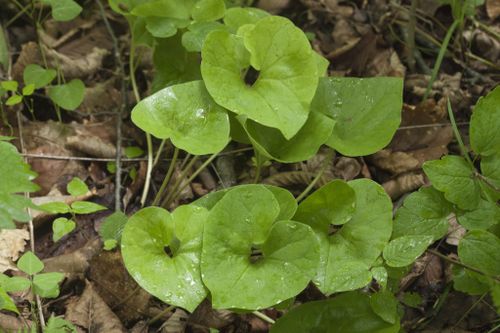
Asarum Sieboldii Miq. is a variant of the genus Asarum in the Aristolochiaceae family, is one of the main sources of Asarum. Can be used as medicine.
Botanical Description
Asarum Sieboldii Miq. is a low-growing herbaceous plant characterized by its distinctive foliage and flowers. The plant typically reaches a height of 10-20 centimeters and spreads through creeping rhizomes, forming dense colonies over time. Its leaves are kidney-shaped to heart-shaped, measuring about 5-10 centimeters in width, with prominent veining.
One of the most intriguing features of Asarum Sieboldii Miq. is its flowers. The flowers emerge in early spring, appearing close to the ground and often hidden beneath the foliage. Each flower consists of three petal-like sepals that are maroon-brown in color, giving the plant its unique appearance. The sepals enclose a small, tubular structure that houses the reproductive organs of the flower. The flowers are typically pollinated by insects, although specific pollinators for this species may vary depending on its geographic location.
Distribution and Habitat
Asarum Sieboldii Miq. is native to East Asia, specifically found in regions such as Japan, Korea, and parts of China. Within its native range, it thrives in shaded woodland areas with rich, moist soil. The plant is often found carpeting the forest floor, forming dense colonies under the canopy of trees. Its ability to spread through rhizomes allows it to colonize suitable habitats efficiently.
Cultural and Medicinal Uses
Throughout history, Asarum Sieboldii Miq. has been valued for both its cultural significance and potential medicinal properties. In traditional East Asian herbalism, various parts of the plant, including the rhizomes and leaves, have been used for their purported medicinal benefits. The plant is believed to possess anti-inflammatory, analgesic, and diuretic properties, among others. However, it’s essential to approach the use of this plant for medicinal purposes with caution, as scientific research on its efficacy and safety is limited.
Some of the conditions for which Asarum Sieboldii Miq. has been traditionally used include:
- Digestive Disorders: In traditional East Asian medicine, it has been used to alleviate digestive issues such as indigestion, bloating, and stomach discomfort.
- Respiratory Conditions: It has been employed to treat respiratory ailments like coughs, colds, and bronchitis. The plant may have expectorant properties that help to loosen mucus and ease breathing.
- Inflammatory Conditions: It has been traditionally used for its purported anti-inflammatory properties. It has been employed to alleviate symptoms of inflammatory conditions such as arthritis and rheumatism.
- Pain Relief: Traditional use includes the application of it externally to alleviate pain, such as headaches or localized pain from injuries or muscle strains.
- Urinary Disorders: Some traditional uses of it include its application for urinary issues, such as urinary tract infections or difficulty urinating. It is believed to have diuretic properties that promote urine flow.
- Menstrual Disorders: In traditional medicine, it has been used to address menstrual irregularities and discomfort associated with menstruation.
In addition to its medicinal uses, Asarum Sieboldii Miq. has also found its way into folklore and mythology in regions where it is native. Legends and stories often associate the plant with themes of concealment and invisibility, adding to its mystique and cultural significance.
Conservation Status
While Asarum Sieboldii Miq. is not currently listed as endangered or threatened, it faces threats from habitat loss, over-harvesting for medicinal purposes, and invasive species encroachment. Conservation efforts focused on preserving its natural habitat and raising awareness about its importance are crucial for ensuring the continued survival of this species.
